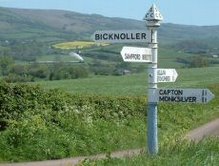
Recent Rule Book update work by certain WSR folks has raised questions, again, about the names of several bridges on the line. And I've been pleased to provide my thoughts.
For example, the bridge to the south of Leigh Loop - the overbridge with a very narrow arch for trains - is commonly known as "Leigh Bridge" and yet the GWR Survey of 1912 has it as "Leighwood Bridge".
That same survey has the rail-over-road bridge between Doniford and Williton as "Water Lane Bridge". This name is sometimes confused with another bridge "Water Bridge" which is at the north end of Leigh Loop, next to Water Farm. A lot of WSR people refer to the one near Doniford as "Liddymore Bridge", after the nearby locality. All a bit confusing. It could be assumed that "Water Lane Bridge" carries the railway over "Water Lane", but no map has been found to confirm the name of the road.
Another act of confusion has been my own doing. Over the years I have taken many a photograph from the un-named bridge to the west of Washford Station. This bridge gives access, over the deep railway cutting, from the main A39 to the fields to the north. I've long considered this elegant bridge to deserve a name and so "Halscombe Bridge" (after the nearby house) appears on photo captions and also on several maps I have produced.
I guess the updated Rule Book will show for each of these bridges one name and one name only.
For example, the bridge to the south of Leigh Loop - the overbridge with a very narrow arch for trains - is commonly known as "Leigh Bridge" and yet the GWR Survey of 1912 has it as "Leighwood Bridge".
That same survey has the rail-over-road bridge between Doniford and Williton as "Water Lane Bridge". This name is sometimes confused with another bridge "Water Bridge" which is at the north end of Leigh Loop, next to Water Farm. A lot of WSR people refer to the one near Doniford as "Liddymore Bridge", after the nearby locality. All a bit confusing. It could be assumed that "Water Lane Bridge" carries the railway over "Water Lane", but no map has been found to confirm the name of the road.
Another act of confusion has been my own doing. Over the years I have taken many a photograph from the un-named bridge to the west of Washford Station. This bridge gives access, over the deep railway cutting, from the main A39 to the fields to the north. I've long considered this elegant bridge to deserve a name and so "Halscombe Bridge" (after the nearby house) appears on photo captions and also on several maps I have produced.
I guess the updated Rule Book will show for each of these bridges one name and one name only.




